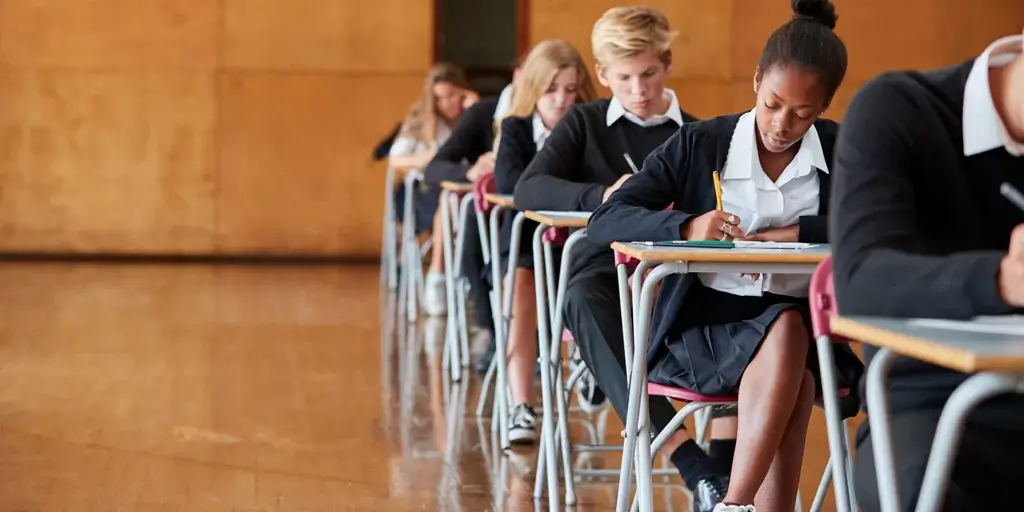From Distress to Success: 8 Tips to Help Your Child Overcome School Anxiety

School can be a source of stress for many children and adolescents, with various pressures triggering feelings of nervousness. Some of these are a normal part of growing up, helping children learn to manage academic and social challenges that will be important later in life, especially in their careers. The real challenge for parents and caregivers is knowing when the pressure becomes too much. It’s crucial to recognize when a child’s stress crosses the line into anxiety that no longer fits their developmental stage, and how this might be affecting their well-being.
What Causes This Type of Anxiety?
Schoolwork-related anxiety can be caused when a child feels that they have high expectations placed on them, i.e. the need to achieve certain marks (to please their parents or teachers) or the need to keep up with the same marks as their friend group (performance-related peer pressure).
This anxiety can also be triggered by a sudden increase in workload. For some children, this happens during school terms where there are many projects and tests. For others, it is related to exam time and the pressure they feel to perform well in exams. School-related anxiety can also often be caused by leaving work to the last minute. Children who are perfectionists or procrastinators may struggle with time management for different reasons.
Lastly, school performance anxiety can be linked to children who may be struggling with underlying or unaddressed learning difficulties. They feel the impact of this but because it has not been diagnosed, they blame themselves for their poor performance and place unrealistic pressure on themselves to do better, often resulting in high anxiety and low self-esteem.
Underlying academic difficulties and disorders include: attention deficit disorder (ADHD and ADD), Dyslexia, Dyscalculia, audio or visual processing disorders and several more.*See reference below for a useful link on academic difficulties.
Signs of Anxiety to Look Out For:
When working with children and teens, professionals look for signs of when stress starts to become distress. This often indicates that the pressure a child is under is no longer developmentally useful and can run the risk of developing into an anxiety disorder.
Signs of distress in children can often show up in various ways, including excessive procrastination, which creates unnecessary strain on both the child and their caregivers, who may feel frustrated by constant reminders and nagging. Additionally, children with perfectionistic tendencies may insist on their work being done in a specific, rigid way, obsessing over neatness or small details, which can heighten anxiety and hinder their ability to complete tasks on time.
Other signs to watch for include frequent complaints of body aches and pains, such as tummy aches or headaches, without any underlying medical cause. This may also include increased bathroom use or changes in stool consistency (like a runny tummy). Children may also experience changes in their sleep or eating habits, such as eating less, struggling to sleep, or waking up during the night. Children who once enjoyed school may begin to exhibit school resistance, crying when being dropped off or refusing to go on test days.
Finally, signs of severe emotional overwhelm include panic attacks related to school attendance, test days, or deadlines, which clearly indicate that the child is struggling to cope. These signs highlight a need for attention and support in managing school-related stress and anxiety.
As parents, you want to try and intervene as early as possible to prevent stress from becoming distress. If you notice your child or teen struggles with anxiety related to their school work, these coping strategies, which can be implemented at home, can help:
8 Coping Strategies to Assist Your Child with School-Related Anxiety:
Teach them time management skills: This is not something that always comes naturally to us. but with the right approach, it can make a big difference. Start by showing them how to break down large tasks into smaller, more manageable steps, which can reduce feelings of overwhelm.
Assist your child in creating realistic to-do lists for the day or week, focusing on one task at a time. Visual aids can be particularly helpful—create a tangible calendar that can be hung on their desk or wall. Use different colours for different subjects and key dates, so it’s easy to see at a glance what’s coming up. Be sure to include when they need to start working on tasks, and not just the deadline date. Don’t forget to incorporate rest days and highlight holidays, so your child has a clear understanding of when they can take a break and recharge.
Establish a healthy study routine: Primary school children can manage 30 minutes of focused study, while pre-teens and teens can manage between 45–60 minutes. Help your child structure their study time into short sessions with breaks in between, and include a longer break for lunch. In the afternoon, aim to decrease study time as they become more tired. Ensure there is a clear end to the day, allowing for proper rest and a calming bedtime routine to look forward to. *A study day routine template is available at the end of this article.
Promote holistic well-being: Encourage a balanced lifestyle that includes dedicated rest time over the weekend as well as out-door activities and extra murals. When school academics becomes the only focus for your child, their performance anxiety increases and their perspective about what is most important can become distorted.
A wholesome diet and reduced sugar intake play a key role in improving concentration, especially for children struggling with academic anxiety. Healthy snacks during long study sessions can help maintain focus and energy levels, as diet and concentration are closely linked in studies.
Sleep is crucial for consolidating a day’s learning and restoring energy. Children and adolescents need around 8-10 hours of sleep to stay cognitively alert and manage emotions effectively. Poor sleep can increase concentration errors and school-related stress.
3 Tips for Better Sleep Hygiene:
Stick to a consistent sleep schedule to allow your body to become familiar with a routine
Avoid screens 30-45 minutes before bed to prevent disruptions (don’t sleep with your phone turned upward next to your bed as light from notifications will subtly disrupt sleep).
Develop a calming bedtime routine, like washing your face to relax and signal the end of the day. “Washing the day and the stress off” can calm your nervous system and make it easier to separate out ‘work’ from ‘rest’ time.
Seek external support: Often, when children are anxious about school expectations they have created a narrative in their head that they interpret as factual. Despite your effort to convince them otherwise, many children with anxiety will tell you that you just don’t understand. In these situations, it can be helpful to arrange a joint conversation with your child and their teacher. The teacher can clearly explain expectations and help your child understand where they may be placing unrealistic pressure on themselves. An external voice of authority often makes a big difference in helping your child adjust their perspective and approach in a healthier, more balanced way.
Help them know when ‘good enough is good enough’: This is especially important for perfectionist children who struggle with submitting work they feel isn't just right. They can spend too much time on tasks, leaving others unfinished and a to-do list that piles up. Teaching them to prioritize tasks, and recognizing that some require more effort than others is crucial here. Emphasize that it’s unrealistic to give 100% to everything, and praise your child’s efforts and process, not just the outcome (as this reinforces the anxiety that the marks are the only important aspect). This approach helps reduce anxiety and fosters more sustainable work habits, allowing your child to get to every task on their list.
Set realistic expectations: Help your child set goals for each day, week and term. Ensure these goals are realistic and inclusive; they can certainly include improvement in academic results but should also include development in their extra murals/social activities to promote a balanced and healthy approach (e.g. clearing a new jump in horse riding / getting a wicket in a cricket game / making a new friend this term).
Develop their EQ and practice healthy coping skills for stress: Help primary school children recognize and name their feelings of anxiety, like ‘nervousness’ or ‘worry’, to reduce overwhelm when they occur. Teach them to notice early signs of stress and use coping strategies, such as calming breathing exercises, daily walks, physical activities, or playing with pets. Creating a dedicated study space separate from their bed, where they can take breaks when needed will reinforce appropriate coping mechanisms for inevitable periods of stress.
Consider your child’s personality: There is no one-size-fits-all approach when it comes to reducing school-related anxiety. Every child responds differently to pressure and affirmation, so try your best to avoid comparisons between siblings or friends. Tailor your approach to your child’s unique personality—some may need clear boundaries and regular structure check-ins, while others might just need some encouragement and reminders of their strengths. Understanding what triggers your child's anxiety will help you address it more effectively.
If you feel there may be an underlying issue that is making school and school work harder for your child to cope with, talk to their teacher and consider getting an educational assessment from an Educational Psychologist. This assessment is able to pick up and manage any learning difficulties or cognitive vulnerabilities that are impacting your child’s academic performance and therefore causing school-related anxiety.
Here’s a Personalized Study Guide template to help manage a busy schoolwork schedule. Feel free to adjust it to fit your child’s needs:
Study Guide (for a non-school day)
08:00 Wake up and eat breakfast
09:30 Study session 1
10:15 Stretch break (leave the room, walk outside, get a snack)
10:30 Study session 2
11:15 Stretch break (leave the room, walk outside, get a snack)
11:30 Study session 3
12:15 Lunch break: have a good lunch!
13:30 Study session 4
14:15 Stretch break (leave the room, walk outside, get a snack)
14:30 Study session 5
15:15 Rest and do something recreational
16:30 or later: A short consolidation session of important aspects studied in the day
17:00 Hooray! You’re done for the day!
Important Tips:
For teens or older children, adjust timing based on when they are most productive. Consider evening sessions if they’re more alert after dinner.
Include clear breaks to avoid burnout. These help keep energy levels up and improve focus.
Ensure there’s a set time to finish studying—no late-night cram sessions or screen time, as this can interfere with sleep and overall well-being.
Resources and References:
Help Guide. Available from: https://www.helpguide.org/family/learning-disabilities
Guide to finding a psychologist in South Africa: https://www.therapyroute.com/therapists/south-
africa/cape-town/1
Square or Box breathing technique for calming down. Available from:
https://www.youtube.com/results?search_query=box+breathing
Related Articles

Teens Online: The Impact of Social Media on Mental Health and How to Protect Them
As of 2023, up to 95% of adolescents aged 13-17 reported using a social media platform, with one-third reporting that they use it almost constantly. Despite 13
Read More

Family Dinner Time- Why is it Important for Your Child?
Life often feels like a whirlwind, with one task blending into the next. Between juggling jobs, school, and social activities, it’s easy to lose the chance to
Read More

Managing Exam Stress: Essential Survival Tips for Parents
As parents, we know that a little bit of stress can actually be a good thing—it can motivate our children and help them focus during exams. This kind of
Read More

We help families find their perfect tutor
Help your child improve their grades and get their confidence back.
GET A TUTOR